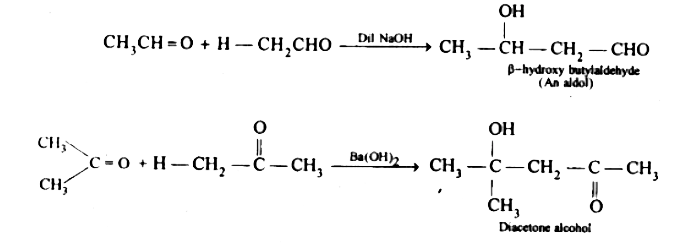What is meant by the following terms ? Give an example of the reaction in each case.
(i) Cyanohydrin
(ii) Acetal
(iii) Semicarbazone
(iv) Aldol
(v) Hemiacetal
(vi) Oxime
(vii) Ketal
(vii) Imine
(ix) 2,4-DNP-derivative
(x) Schiff’s base
(i) Cyanohydrin: gem-Hydroxynitriles, i.e., compounds possessing hydroxyl and cyano groups on the same carbon atom are called cyanohydrins. These are produced by addition of HCN to aldehydes or ketones in a weakly basis medium.

(ii) gem - Dialkoxy compounds in which the two alkoxy groups are present on the terminal carbon atom are called acetals. These are produce of an aldehyde with two equivalents of a monohydric alcohol inpresence of dry HCl gas.

These are easily hydrolysed by dilute mineral acids to regenerate the original aldehydes. Therefore, these are used for the protectionof aldehyde group in organic synthesis
(iii) Semicarbazones are derivatives of aldehydes and ketones and are produced by action of semicarbazide on them in acidic medium.

(iv) Aldols are P-hydroxy aldehydes or ketones and are produced by the condensation of two molecules of the same or one molecule each of two different aldehydes or ketones in presence of a dilute aqueous base. For example,

(v) gem - Alkoxyalcohole are called hemiacetals. These are produced by addition of one molecule of a monohydric alcohol to an aldehyde in presence of dry HCl gas.
(vi) Oximes are produced when aldehydes or ketones react with hydroxyl amine in weakly acidic medium. ltvrgt 
(vii) Ketals are produced when a ketone is heated with dihydric alcohols lide ethylene glycol in presence of dry HCl gas or /3- toluene sulphonic acid (PTS).

These are easily hydrolysed by dilute mineral acids to regenerate the original ketones. Therefore, ketals are used for protecting keto group in organic synthesis.
(viii) Compounds containing -C=N - group are called imines. These are produced when aldehydes and ketones react with ammonia derivatives.

(ix) 2, 4- Dinitriphenyl hydrazone (i.e., 2,4-DNP derivatives) are produced when aldehydes or ketones react with 2,4-dinitrophenyl hydrazine in weakly acidic medium.

(x) Aldehydes and ketones react with primary aliphatic or aromatic amines to form azomethines or SchifFs bases.

Topper's Solved these Questions
Similar Questions
What is meant by the following terms ? Give an example of the reaction in each case.
(i) Cyanohydrin
(ii) Acetal
(iii) Semicarbazone
(iv) Aldol
(v) Hemiacetal
(vi) Oxime
(vii) Ketal
(vii) Imine
(ix) 2,4-DNP-derivative
(x) Schiff’s base
View SolutionWhat is meant by the following terms ? Give an example of the reaction in the case.
i. Cyanohydrin ii. Actal
iii. Semicarbazone iv. Aldol
v. Hemiacetal vi. Oxime
vii. Ketal viii. Imine
ix. 2,4-DNP derivative x. Schiff's base
View Solution
Knowledge Check
Which of the following molecules are diatomic ?
(i) Nitrogen (ii) Neon (iii) Oxygen
(iv) Sulphur (v) Phosphorus (vi) Ozone
(vii) Fluorine (viii) Hydrogen (ix) FullereneAii,iv,v and viBiv,v and ixCii and viDI,iii,vii and viiiThe total number of carbonate ores among the following is . ltBRgt (i) Argentite (ii) Calamine (iii) Malachite (iv) Siderite (v) Galena (vi) Magnetite (vii) Dolomite (viii) Cassiterite (ix) Bauxite
A4B5C6D7
(a) What is meant by the following terms ? Give an example of the reaction in each case. (i)Aldol (ii)Semicarbazone
(b) Complete the following :
(i) CH3COClH2Pd−BaSo4−−−−−−−−→
(ii)CH3−CH=CH−CNDIBAl−H−−−−−−→

View SolutionI In the following expressions, write a letter and a binary expression. (i) 3x + 4y (ii) 9 + 3y (iii) 4a - 7b 5r +1 (v) a-30 (vi) 4ab (vii) abc - 1 (vii) 3xy (ix) ab + bc (viii)a + abc
View SolutionHow many of the following are oxides ores
(i) Carnalite (ii) Cuprite
(iii) Cassiterite (iv) Chromite
(v) Cinnabar (vi) Calamine
(vii) Cerussite (Viii) Chalocopyrite
(ix) Chalcocite
View SolutionHow many of the following are oxides ores
(i) Carnalite (ii) Cuprite
(iii) Cassiterite (iv) Chromite
(v) Cinnabar (vi) Calamine
(vii) Cerussite (Viii) Chalocopyrite
(ix) Chalcocite
View SolutionClassify the following into elements, compounds and mixtures
(i) Marble (ii) Honey (iii) Touch paste (iv) Sugar (v) Gold (vi) Brass (vii) Nitre (viii) Slakes lime (ix) Nitrogen (x) Fruit juice.
View SolutionHow many among the following are biodegradable polymers?
(i) Polyhydroxybutyrate (PHB)
(ii) PHBV
(iii) SBR
(iv) Polyglycolic acid
(v) Bakelite
(vi) Thiokol
(vii) Nylon-2-Nylon-6
(vii) PMMA
(ix) Nylon-6, 6.
View Solution
